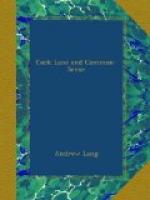Bovet, in his Pandaemonium (1684), gives an account of the Demon of Spraiton, in 1682. His authorities were ‘J. G., Esquire,’ a near neighbour to the place, the Rector of Barnstaple, and other witnesses. The ‘medium’ was a young servant man, appropriately named Francis Fey, and employed in the household of Sir Philip Furze. Now, this young man was subject to ’a kind of trance, or extatick fit,’ and ’part of his body was, occasionally, somewhat benumbed and seemingly deader than the other’. The nature of Fey’s case, physically, is clear. He was a convulsionary, and his head would be found wedged into tight places whence it could hardly be extracted. From such a person the long and highly laughable tale of ghosts (a male ghost and a jealous female ghost) which he told does not much win our acceptance. True, Mrs. Thomasin Gidley, Anne Langdon, and a little child also saw the ghost in various forms. But this was probably mere fancy, or the hallucinations of Fey were infectious. But objects flew about in the young man’s presence. ’One of his shoe-strings was observed (without the assistance of any hand) to come of its own accord out of his shoe and fling itself to the other side of the room; the other was crawling after it (!) but a maid espying that, with her hand drew it out, and it clasp’d and curl’d about her hand like a living eel or serpent. A barrel of salt of considerable quantity hath been observed to march from room to room without any human assistance,’ and so forth. {122}
It is hardly necessary to add more modern instances. The ’electric girl’ Angelique Cottin, who was a rival of Ann Robinson, had her powers well enough attested to arouse the curiosity of Arago. But, when brought from the country to Paris, her power, or her artifice, failed.
It is rather curious that tales of volatile furniture are by no means very common in trials for witchcraft. The popular belief was, and probably still is, that a witch or warlock could throw a spell over an enemy so that his pots, and pans, tables and chairs, would skip around. The disturbances of this variety, in the presbytery at Cideville, in Seine Inferieure (1850), came under the eye of the law, because a certain shepherd injudiciously boasted that he had caused them by his magic art. {123a} The cure, who was the victim, took him at his word, and the shepherd swain lost his situation. He then brought an action for defamation of character, but was non-suited, as it was proved that he had been the fanfaron of his own vices. In Froissart’s amusing story of Orthon, that noisy sprite was hounded on by a priest. At Tedworth, the owner of the drum was ‘wanted’ on a charge of sorcery as the cause of the phenomena. The Wesleys suspected that their house was bewitched. But examples in witch trials are not usual. Mr. Graham Dalyell, however, gives one case, ‘the firlote rynning about with the stuff popling,’ on the floor of a barn, and one where ’the sive and the wecht dancit throw the hous’. {123b}




